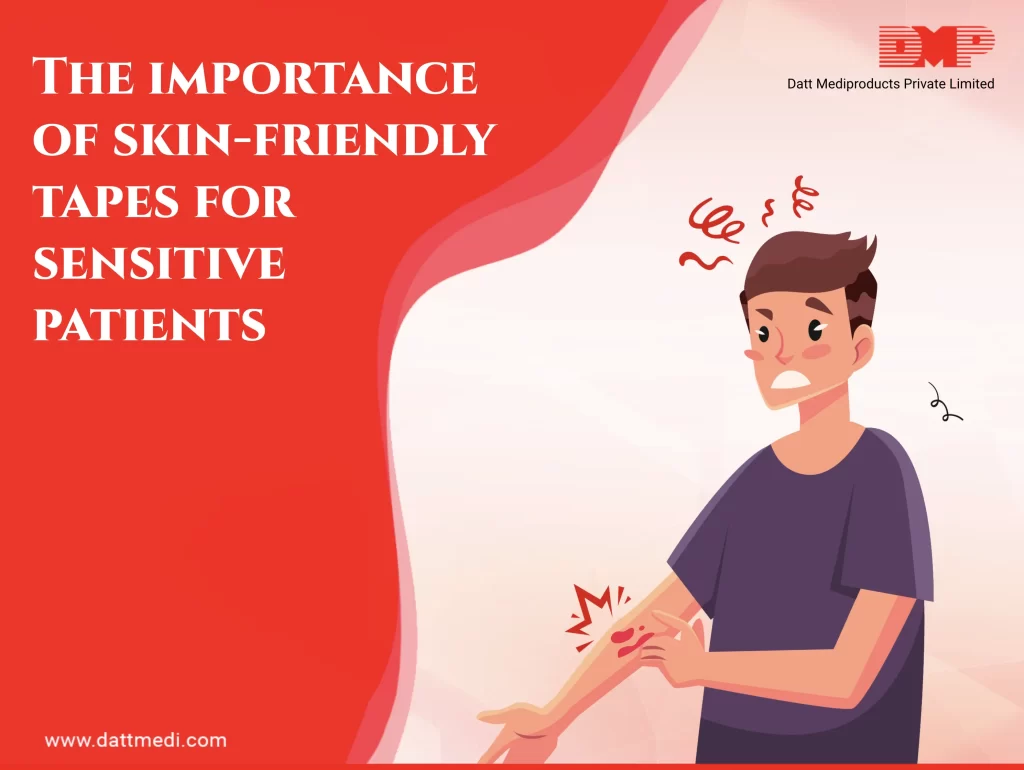
In the realm of healthcare, attention to detail is paramount, especially when it comes to catering to the needs of sensitive patients. One often overlooked aspect is the choice of medical tapes for securing dressings, tubes, and medical devices.
For individuals with delicate or sensitive skin, such as pediatric patients, the elderly, and those with skin conditions, the selection of appropriate tapes can make a significant difference in their comfort and recovery process. This blog will cover the importance of skin-friendly tapes like Minipore™, Velpore™, and Velsilk™ in enhancing patient care and promoting healing.
Understanding the Sensitivity
Sensitive skin can be a result of various factors, such as age, skin conditions, or prolonged exposure to medical treatments. Patients undergoing chemotherapy, individuals with dermatitis, or those with compromised immune systems require extra care to prevent skin damage. Traditional medical tapes, while effective in securing medical devices, can sometimes cause irritation, allergic reactions, or damage to fragile skin. This is precisely where the importance of skin-friendly tapes becomes conspicuous
Introducing Minipore™, Velpore™, and Velsilk™ Tapes
Minipore™, Velpore™, and Velsilk™ are revolutionary medical tapes designed to address the unique needs of sensitive patients. These tapes stand out for their skin-friendly properties and their contribution to patient comfort.
Minipore™:
Minipore™ tape is a hypoallergenic paper tape that offers gentle adhesion, making it suitable for patients with sensitive or fragile skin. It allows for breathability, reducing the risk of skin maceration while securely holding dressings in place.
Read more about products visit https://dattmedi.com/minipore.html
Velpore™:
Velpore™ surgical paper tape possesses hypoallergenic qualities, making it ideal for individuals with sensitive skin or allergies. Its gentle nature ensures it is kind to the skin. The microporous structure of Velpore enables exceptional breathability, facilitating airflow and minimizing the likelihood of maceration.This tape is frequently utilized for securing wound dressings, delivering dependable fixation while enabling freedom of movement and flexibility. Its mild adhesive properties allow for painless and damage-free removal from the skin.
Read more about products visit https://www.dattmedi.com/velpore.html
Velsilk™:
Velsilk™ tape is a silk-like cloth tape that combines excellent adhesion with gentle removal. It adheres securely to the skin while minimizing discomfort during tape removal. It is particularly useful in situations where frequent dressing changes are required, as it allows for easy application and removal.
Read more about products visit https://www.dattmedi.com/velsilk.html
Advantages of Skin-Friendly Tapes
The importance of using skin-friendly tapes like Minipore™, Velpore™, and Velsilk™ cannot be overstated. Here are some key advantages they offer:
- Reduced Skin Irritation: The hypoallergenic adhesive and soft materials minimize the risk of skin irritation or allergic reactions, promoting patient comfort during the healing process.
- Enhanced Healing: Breathable materials enable proper air circulation around wounds, supporting the body’s natural healing mechanisms.
- Painless Removal: The gentle adhesive used in these tapes ensures painless removal, reducing the potential for skin trauma.
- Versatility: Skin-friendly tapes are versatile in their applications, suitable for various medical scenarios, from wound dressings to tubing fixation.
- Patient Confidence: Patients experience enhanced comfort and security, which can have a positive impact on their overall well-being and recovery.
When it comes to healthcare, the focus should always be on patient well-being and comfort. The use of skin-friendly tapes like Minipore™, Velpore™, and Velsilk™ exemplifies this commitment. These tapes not only provide reliable adhesion for medical devices but also prioritize patient comfort and skin health



